يشبه برنامج إدارة الموارد خريطة الطريق: فهو يوفر إرشادات واضحة حول كيفية تقسيم جميع مواردك للوصول إلى هدف محدد.
تمامًا كما ترشد خريطة الطريق المسافرين إلى وجهتهم، تساعد برمجيات إدارة الموارد المؤسسات على تحسين تكاليف المشروع أو أعضاء الفريق أو القوى العاملة، وأدوات مثل برنامج إدارة المشاريع أو مساحة مادية محددة لضمان أقصى قدر من الإنتاجية.
سنوضح لك في هذا الدليل قواعد اللعبة، وما يتطلبه الأمر لتبسيط عملية إدارة الموارد من البداية إلى النهاية، وسنسلط الضوء على بعض النماذج لبدء رحلتك.
دعنا ندخل في صلب الموضوع.

ما هي إدارة الموارد؟
إدارة الموارد هي عملية إدارة موارد الأعمال بكفاءة مثل الأصول أو الموارد المالية أو العمالة لتحقيق أفضل النتائج في الإطار الزمني الأكثر كفاءة.
تتضمن التقنيات الشائعة لإدارة الموارد التخطيط والتحكم والإشراف على استخدام رأس المال والموارد البشرية والتكنولوجيا والمعلومات والأصول. وتعتمد الإدارة السليمة للموارد على نجاح كيفية التحكم في توافر الموارد وقدرة الموارد.
يساعدك تخطيط إدارة الموارد - أو التنبؤ بالموارد - على ضمان بقائك في حدود الميزانية، وتخصيص العمل لفريقك بشكل مناسب، وإدارة البيانات أو أدوات العمل .
لماذا تعتبر إدارة الموارد مهمة؟
تعتبر إدارة الموارد مهمة لأنها تضمن لك تحسين الموارد بكفاءة حتى يتمكن مديرو المشاريع أو مديرو الموارد من تقليل التكاليف وتعظيم النتائج.
بالإضافة إلى ذلك، يساعد تخطيط الموارد أيضًا المؤسسات على وضع استراتيجية للمستقبل بحيث تتوفر الموارد المناسبة عند الحاجة إليها. يعد استخدام تقنيات إدارة الموارد الصحيحة أمرًا بالغ الأهمية للشركات لأنه يساعد على ضمان تسليم المشاريع في الوقت المحدد.
تستخدم فرق العمل برنامج إدارة الموارد للاستعداد لنقص الموارد أو أي تغييرات كبيرة قادمة في المستقبل. وتتمثل فائدة إدارة الموارد بشكل أساسي في الاستفادة من إدارة المخاطر بشكل أفضل.
المكافأة:_
_/مرجع/ _https://clickup.com/blog/erp-software-tools// أدوات تخطيط موارد المؤسسة* %/%href/_
الأنواع الـ 4 الشائعة لإدارة الموارد
1. تخصيص الموارد تخصيص الموارد يضمن توفر الموارد المناسبة في المكان المناسب وفي الوقت المناسب. تحدد المنظمات أولويات مهام المشروع وتتأكد من استخدام الموارد المناسبة في كل مهمة. يقلل تخصيص الموارد من تكاليف المشروع ويزيد من النتائج.
يسمح هذا النوع من إدارة الموارد أيضًا للفرق بمعرفة أفضل طريقة لتوظيف الفريق. وهذا مهم جدًا عند تخصيص العمل لمشروع ما أو استخدام مهارات موظفين محددين لمنحك ميزة تنافسية.
وإذا لم تقم بتخصيص الموارد بشكل فعال، فإنك تخاطر بأعباء عمل غير متوازنة، مما قد يؤدي إلى إرهاق الموظفين أو استيائهم.
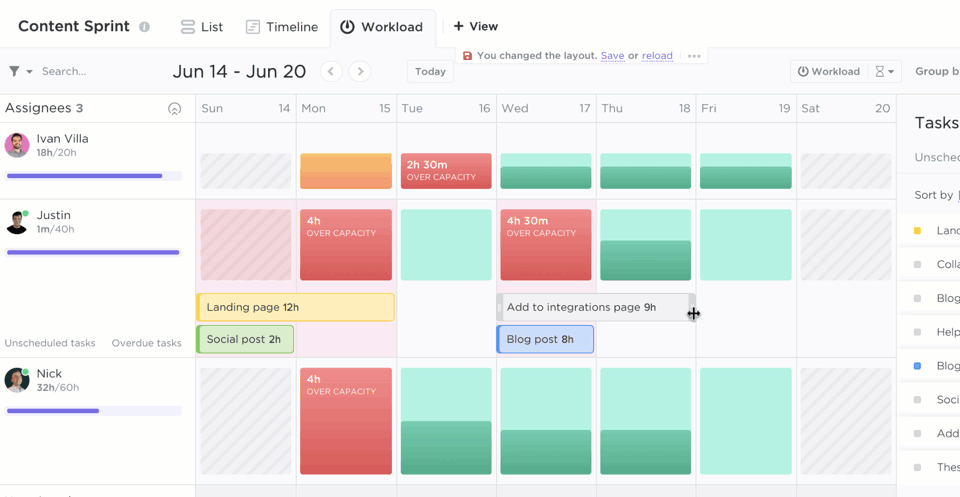
استخدم طريقة عرض عبء العمل في ClickUp لمعرفة من هو متقدم أو متأخر وسحب المهام وإفلاتها بسهولة لإعادة تخصيص الموارد
تمثل المحسوبية تحديًا كبيرًا يجب على قادة الفرق تجنبه. لهذا السبب أنت بحاجة إلى حل فعال لإدارة الموارد يعطي نظرة شفافة على العمل المخصص أو الميزانية المقررة لفريقك.
2. استخدام الموارد
كيف يتم استخدام الموارد على وجه التحديد للوصول إلى هدفك؟ استخدام الموارد يتيح لك فهم كيفية استخدام جميع مواردك، ومتى تكون هناك حاجة إليها، وكيفية تخصيصها لتحقيق النتيجة المرجوة.
يساعد ذلك أعضاء الفريق على تجنب العمل على نفس الموارد حتى لا تضع كل بيضك في سلة واحدة. وإذا كنت مديراً للموارد، فإنك تحتاج إلى الاستفادة من أشياء مثل مهارات أعضاء فريقك.
إذا كنت تدير فريق تسويق المحتوى وكنت ملتزمًا بموعد نهائي صارم للمشروع، فلن تستخدم مؤلفي النصوص لإنتاج أوراق بيضاء أو أدلة متعمقة أو تجعل كتابك الطوال يعملون على نسخ البريد الإلكتروني. استخدام الموارد يضمن عمل أعضاء الفريق على المشاريع المتعلقة بخبراتهم.
3. تسوية الموارد تسوية الموارد -أو تسوية الموارد- هي عملية إدارة الموارد مقدمًا لضمان توازن الطلب على الموارد مع العرض. ببساطة، تتيح لك عملية تسوية الموارد نقل الموارد المتاحة لديك إلى مشاريع أخرى حتى لا تفرط في تحميل فرق العمل أو تضيع وقتها في انتظار العمل.
بصفتك مؤسسة، فأنت تريد أن يكون لديك الموارد المناسبة في متناول اليد عند الحاجة إليها. تضمن تسوية الموارد حدوث ذلك. وهذا ينطبق بشكل خاص على العاملين في الخدمات الاحترافية.
في بعض الأحيان يحتاج بعض العملاء إلى تغطية أو وقت أكثر من غيرهم. تتيح لك تسوية الموارد توزيع العمل بالتساوي على فريقك لزيادة كفاءة الموارد إلى أقصى حد.
هل تبحث عن المزيد حول إدارة محفظة المشاريع للعملاء؟ اطلع على قائمتنا الخاصة بـ أفضل برامج إدارة محافظ المشاريع متوفر!_
4. التنبؤ بالموارد
يساعد التنبؤ بالموارد على التخطيط للاحتياجات المستقبلية من الموارد مع توقع أي تغييرات قد تحدث بسبب عوامل خارجية. سواء كان ذلك من خلال تحليل البيانات التاريخية أو استخدام نماذج تنبؤية لتحديد الاحتياجات المستقبلية من الموارد وتوافرها، فإن التنبؤ بالموارد مهم للبقاء ضمن نطاق مشروعك.
التخطيط المستقبلي لمشاريعك القادمة هو أسلوب إدارة الموارد الذي يحميك من الوقوع في صدمة عمياء.
أمثلة على إدارة الموارد
بشكل عام، تنقسم موارد المشروع إلى فئتين:
- الموارد غير الملموسة: الأفكار والعمليات والمهارات والملكية الفكرية
- الموارد الملموسة: البرامج والمواد,موارد التسويق العقاريوالموارد البشرية
سيقوم كل فريق بإدارة قائمة موارد متشابهة إلى حد ما. وتشمل هذه الموارد
- ساعات العمل
- المهارات
- القوى العاملة
- ميزانيات المشاريع
- المواد
لنكون أكثر تحديداً، إليك الموارد التي ستستخدمها على الأرجح والتي تندرج ضمن كل فئة:
- الموارد البشرية (الموظفون والمتعاقدون والمتدربون والمتطوعون)
- الموارد (الموردون، البائعون، الشركاء)
- الاتصالات (الاجتماعات والمحادثات)
- المواد (المعدات والتكنولوجيا والأدوات)
- الموارد المالية (الميزانية، التمويل,النفقات)
- الملكية الفكرية (العمليات، الأفكار، المعرفة)
- العقارات (مساحة، مكتب، مساحة عمل)
- الوقت (المواعيد النهائية والجداول الزمنية والمعالم)
- البرمجيات (التطبيقات والمنصات والأدوات)
الآن بعد أن تعرفت على الموارد النموذجية التي تعمل بها الفرق، دعنا نلقي نظرة عامة على الخطوات المتبعة في إدارة الموارد.
كيف تبني عملية فعالة لإدارة الموارد
سيضمن لك الإعداد والتخطيط تحقيق أقصى استفادة من مواردك. وبالنسبة للجزء الأكبر، يمكن تقسيم إدارة الموارد إلى أربع مراحل عامة:
الخطوة 1: اختر أداة إدارة الموارد القابلة للتخصيص لتلبية احتياجاتك
يحتاج مدير الموارد الخاص بك إلى برامج وقدرات أتمتة لتشغيل المشاريع والإشراف عليها على أفضل وجه. والأهم من ذلك أن التخصيص مهم في برامج إدارة الموارد لأنه يتيح لمديري الموارد لديك تبسيط العمليات وزيادة الدقة ومراقبة مشاريع متعددة في وقت واحد.
ومع الأتمتة، يمكن لمديري الموارد إنشاء التقارير بسرعة، وتحليل البيانات في الوقت الفعلي، وتحديد مجالات تحسين المشروع. ومع ازدياد تعقيد المشاريع وحساسيتها للوقت، فإن البرمجيات والأتمتة تجعل جمع البيانات وتحليلها دقيقاً.

اطلع على أكثر من 15 طريقة عرض في ClickUp لتخصيص سير عملك وفقًا لاحتياجاتك
وهذا يوفر الوقت لمديري الموارد للتركيز على المهام ذات المستوى الأعلى. تسهل الأتمتة أيضًا تتبع التقدم المحرز والتنبؤ بالتغييرات، ومراقبة أداء الفريق واستخدامه، وتتبع الموارد المخصصة.
فبدون برنامج إدارة الموارد والميزات الآلية التي تأتي مع أدوات إدارة المشاريع القابلة للتخصيص، تتحرك المهام بوتيرة بطيئة بسبب العمل اليدوي المطلوب. 🐌
الخطوة 2: تخطيط وتحديد الموارد المتاحة لديك
الخطوة الأولى في تخطيط السعة هو تحديد جميع الموارد المتاحة. ويشمل ذلك الموارد المادية والبشرية، وكذلك أي موارد غير ملموسة مثل المال والمعلومات.
بمجرد تحديد الموارد، من المهم تقييم كل مورد لتحديد قيمته وأهميته. 🗺️
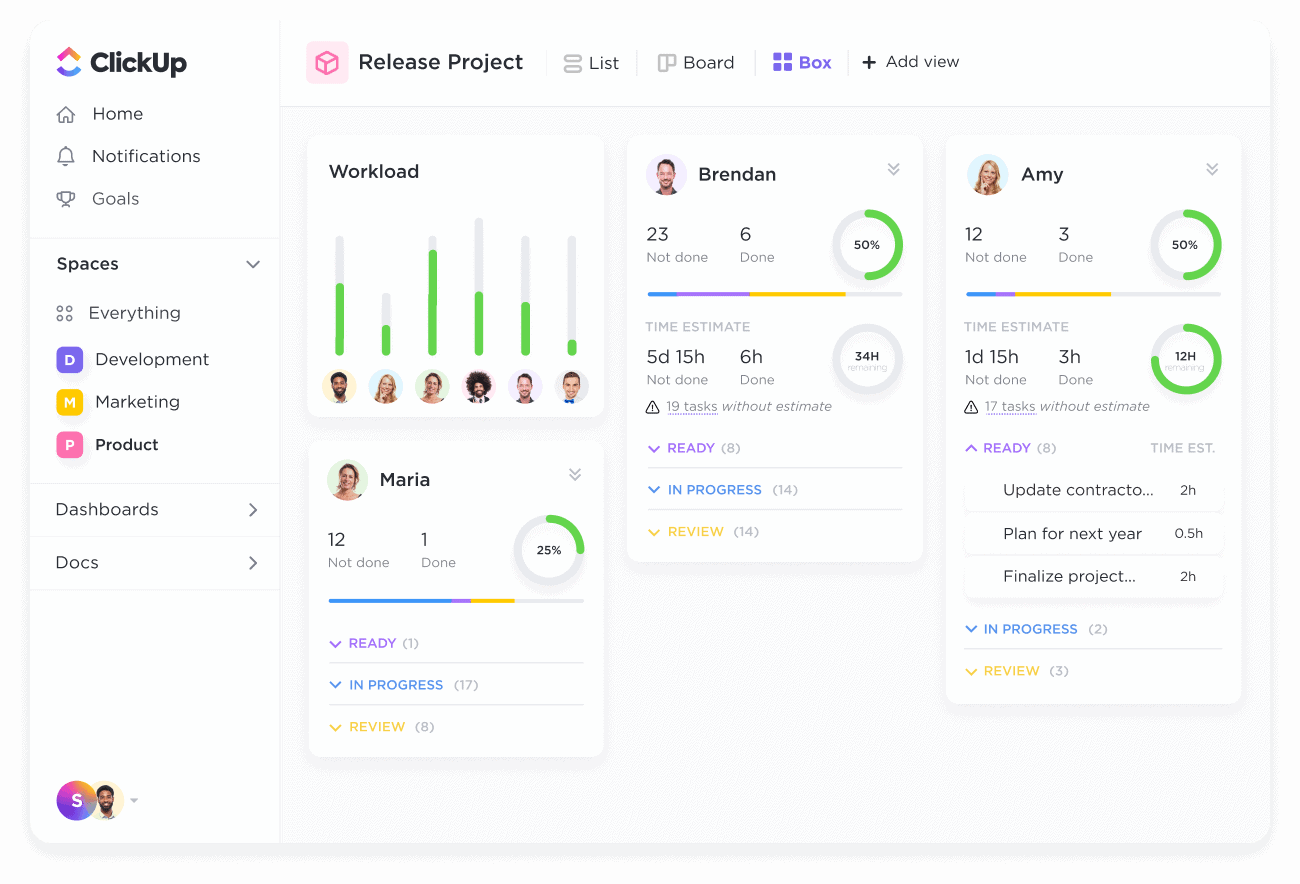
تتيح لك طريقة عرض المربع رؤية ما يعمل عليه فريقك وما أنجزوه وما هي قدراتهم
الخطوة التالية هي وضع خطة لاستخدام الموارد بفعالية. قد تتطلب سعة مواردك وضع إجراءات وجداول زمنية محددة لتحسين استخدام الموارد. أو قد تتضمن إنشاء ميزانية لتخصيص الموارد بشكل مناسب.
الخطوة 3: تتبع مواردك للمشاريع المستقبلية
تسهل أتمتة إدارة الموارد على مديري المشاريع إدارة الميزانيات, تخطيط سباقات السرعة وتلبية قيود الجدول الزمني. إحدى الطرق السهلة للقيام بذلك هي استخدام أدوات إدارة المشاريع والتعاون في ClickUp.
إليك نظرة عامة على ما هو ممكن بمساعدة ClickUp:
- أنشئ مشروعاً: أولاً، أنشئ مشروعاً في ClickUp وقم بتسميته. سيكون هذا هو المشروع الرئيسي الذي سيتم تخصيص مواردك له.
- حدد الموارد المتاحة: حدد الموارد المتاحة للمشروع وقم بإدراجها في قائمة. وهذا يشمل كلاً من الموارد البشرية (مثل المهندسين والمصممين ومؤلفي النصوص) بالإضافة إلى الأصول الأخرى مثل البرامج والميزانية والمواد.
- تعيين المهام: قم بإنشاء المهام وتعيينها إلى عضو الفريق المناسب. هذا يجعل من السهل تتبع تقدم المهام فيما يتعلق بالموارد المخصصة لها.
- تعيين الميزانيات: ضع ميزانية لكل مورد وتأكد من تتبعها طوال مدة المشروع للحفاظ على فريقك ضمن الميزانية.
- تتبع الاستخدام: يتيح لك ClickUp تتبع الموارد المتاحة في الوقت الفعلي لمراقبة التقدم المحرز بسهولة وتعديل الموارد بسرعة إذا لزم الأمر.
- إنشاء تقارير: إنشاء تقارير عن استخدام الموارد والميزانيات لمراجعة الأداء العام. احصل على بيانات في الوقت الفعلي لضمان بقاء المشروع على المسار الصحيح من خلال أدوات ClickUp القابلة للتخصيص ولوحة التحكم.

تتيح لك طريقة عرض المربع رؤية ما يعمل عليه فريقك وما أنجزوه وما هي قدراتهم
باتباع هذه الخطوات النموذجية مع أدوات مثل ClickUp، تضمن سير مشاريعك بسلاسة أكبر ضمن منصة مركزية واحدة.
الخطوة 4: التنبؤ أو وضع فرضية لمشاريعك المخطط لها
التنبؤ هو عملية تخطيط تتضمن التنبؤ بالاحتياجات المستقبلية من الموارد بناءً على الاتجاهات الحالية والمتوقعة. إنها خطوة حاسمة في إدارة الموارد لأنها تتضمن توقع النقص أو الفائض المحتمل في الموارد المتاحة.
للقيام بذلك، قد يستخدم مدير الموارد مجموعة متنوعة من التقنيات والأدوات، بما في ذلك التحليل التاريخي والتنبؤ بالاتجاهات والتحليلات الكمية.
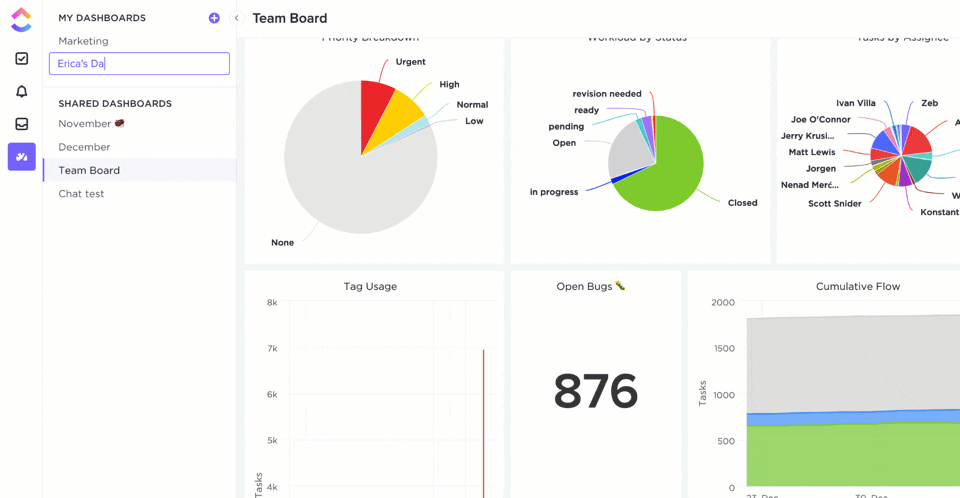
اعثر على البيانات التي تحتاجها على الفور باستخدام الأدوات في لوحات معلومات ClickUp Dashboards
فهي تستفيد من مجموعة متنوعة من مصادر المعلومات، بما في ذلك البيانات المالية، وبيانات القوى العاملة، واتجاهات الصناعة، وطلب العملاء، وأنشطة المنافسين لتقييم السيناريوهات المستقبلية الأكثر احتمالاً والاستعداد وفقًا لذلك.
أفضل أدوات إدارة الموارد التي يمكنك استخدامها كليك أب يجعل إدارة الموارد أسهل من أي وقت مضى. توفر طرق العرض القابلة للتخصيص عرضًا سريعًا لمن هو المسؤول عن أي مهمة. أفضل جزء هو أنه يمكنك استخدام تقنيات إدارة الموارد التي تعلمتها حديثًا لتعيين المهام للأشخاص المناسبين وتحديد المواعيد النهائية التي ستشعر بالثقة في الالتزام بها.
كما أن ميزاته القوية مثل تبعيات المهام وإعدادات الأولوية وأدوات التواصل المدمجة تجعلك غير مضطر لاستخدام مليون منصة أخرى لإنجاز العمل. على سبيل المثال، تعد مشاركة مستندات المشروع وتخزينها أمرًا سهلاً، كما أن التعاون أسهل مع خاصية ClickUp التعاونية السبورة الأدوات 📝

قم بتخصيص اللوحات البيضاء بسهولة عن طريق إضافة المستندات والمهام والمزيد
باستخدام طرق عرض مخطط جانت، يمكن للفرق تصور مهامهم وتحديد الاختناقات المحتملة خلال العملية. ليس هذا فقط، ولكن كأداة إدارية، فهي قابلة للتخصيص بالكامل، لذا فهي تتوافق مع احتياجات إدارة الموارد الخاصة بك بدلاً من العكس.
أفضل ميزات أداة إدارة الموارد ### أفضل الميزات لأداة إدارة الموارد
يحتاج مدير المشروع إلى رؤية الصورة الأكبر، وإنشاء تدفقات عمل فعالة، وتعظيم تأثير مشاريعه. لحسن الحظ، فإن بعض أفضل ميزات ClickUp لإدارة الموارد تفعل ذلك بالضبط:
- التقويمات وعروض المشروع: تصور الموارد والمهام في الوقت الفعلي باستخدام الجداول الزمنية والتقويمات والعروض التفاعلية.📈
- إسناد المهام: أضف إمكانية رؤية من هو المسؤول عن ماذا حتى يكون كل فرد في فريقك على اطلاع دائم وتظل عملية تحديد مستوى الموارد لديك عادلة.
- لوحات المعلومات المخصصة: قم بتحليل أداء الموارد من خلال لوحات المعلومات المصممة خصيصًا مع الأدوات الأكثر صلة من اختيارك.🛠️
- إعداد التقارير: إنشاء تقارير لتحديد كفاءة الموارد والقدرة الاستيعابية وغير ذلك.
- الأتمتة القابلة للتخصيص: أتمتة تعيينات الموارد وتحديث حالة المشروع لتوفير الوقت. ⏰
هذا ليس كل شيء. تحصل الفرق على إمكانية الوصول إلى طن من القوالب والعديد منها مصمم خصيصًا لإدارة الموارد. إليك نظرة فاحصة على بعض القوالب التي يمكنك استخدامها لإدارة الموارد بشكل أفضل.
3 قوالب لإدارة الموارد قابلة للتخصيص تحتاج إلى تجربتها
قوالب إدارة الموارد من ClickUp مفيدة للغاية لمديري المشاريع أو الموارد. فهي توفر الوقت الثمين من خلال السماح لمديري المشاريع ببدء المشاريع بسرعة دون الحاجة إلى البدء من الصفر.
تم تصميم قوالب إدارة الموارد لمساعدة الفرق على تطوير سير العمل بكفاءة، وتحسين استخدام الموارد، وزيادة تأثيرها إلى أقصى حد. وهي تتضمن ميزات مثل تبعيات المهام، وإعدادات الأولوية، وأدوات الاتصال المدمجة.
1. قالب تخطيط الموارد ClickUp
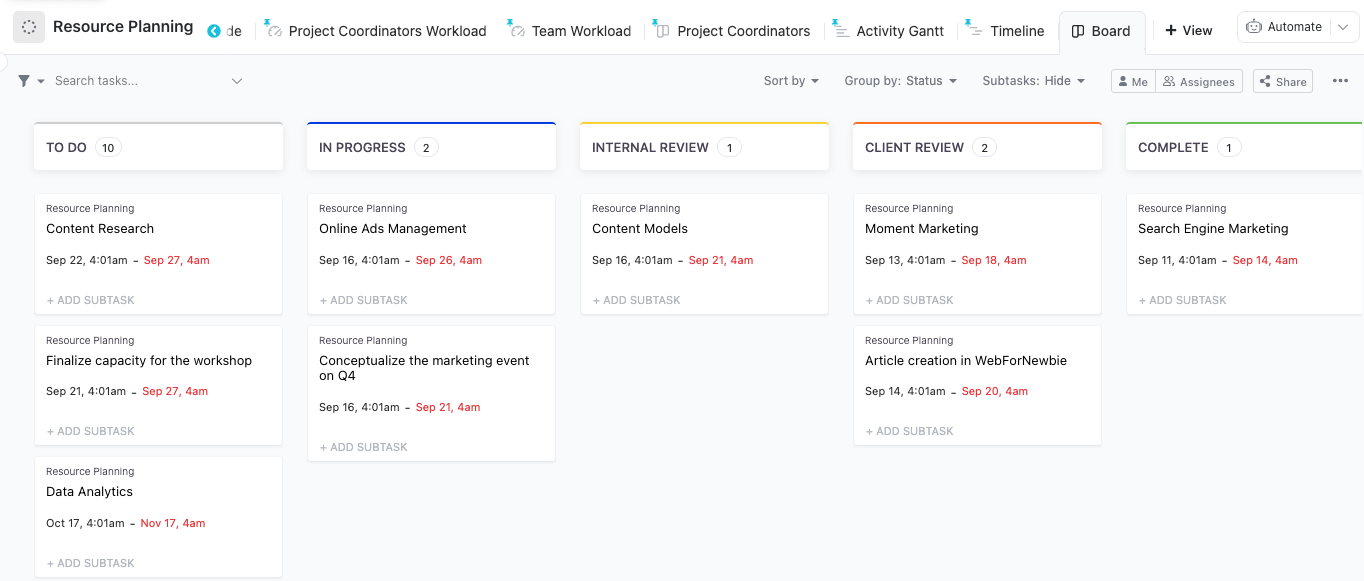
قم بتوزيع الموارد بسهولة باستخدام قالب تخطيط الموارد من ClickUp
قالب تخطيط الموارد قالب تخطيط موارد ClickUp هو أداة رائعة للفرق التي تحتاج إلى بدء العمل بسرعة مع خطة إدارة الموارد. تمنحك طريقة عرض عبء العمل رؤية واضحة للقدرة الحقيقية لفريقك واستخدامه.
وعرض لوحة كانبان رائع لمدير المشروع الذي يحتاج إلى سير عمل مرئي لإدارة الموارد وميزات السحب والإفلات البسيطة.
/ctaBtn/الأخضر https://app.clickup.com/signup?template=t-200533044 تنزيل هذا القالب /%ctaBtntn/
2. قالب تخصيص الموارد ClickUp
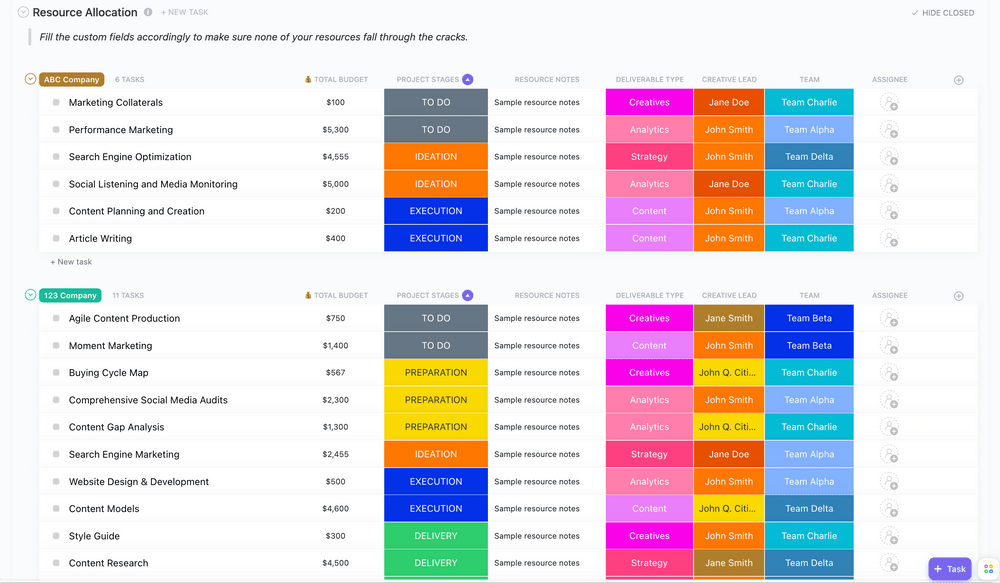
استخدم قالب تخصيص الموارد الخاص بـ ClickUp لتتبع المواد والقوى العاملة وما شابه ذلك لكل مشروع.
هل تريد المزيد من ميزات السحب والإفلات القابلة للتخصيص لنقل المهام والمهام والمهام الفرعية عبر الحالات؟ يمكنك استخدام قالب تخصيص الموارد ClickUp مصمم خصيصًا مع وضع احتياجاتك الخاصة في الاعتبار.
يجعل قالب إدارة الموارد هذا من السهل معرفة أين يتم استخدام جميع مواردك، وتتيح لك الحقول المخصصة تتبع الميزانيات عبر مهام محددة.
/ctaBtn/الأخضر https://app.clickup.com/signup?template=t-31487zh تنزيل هذا القالب /%ctaBtntn/
3. قالب مصفوفة موارد ClickUp
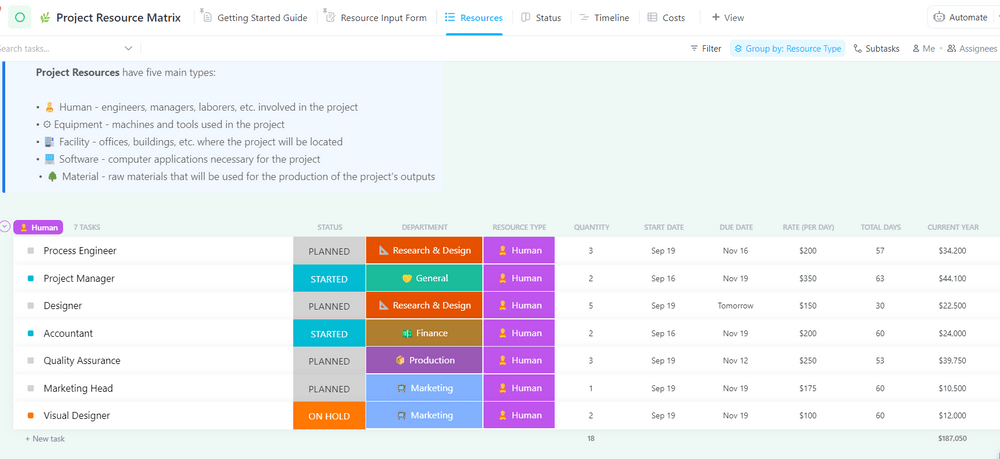
خطط مواردك بفعالية باستخدام قالب المصفوفة هذا لتحديد التكلفة الإجمالية المتوقعة لمواردك المتاحة
احتفظ دائمًا بإصبعك على التكلفة الإجمالية المتوقعة للموارد باستخدام قالب مصفوفة موارد ClickUp هذا القالب مثالي للمبتدئين ويأتي مع خمس حالات وستة حقول مخصصة لتنسيقها حسب احتياجاتك.
سواء كان الأمر يتعلق بالساعات أو الميزانيات أو تكاليف المشروع، فإن هذا القالب هو حل جيد لإدارة الموارد مع عرض واضح للحالة ونوع المورد والموعد النهائي وأي معلومات مالية أخرى تحتاج إلى تتبعها.
/ctaBtn/الأخضر https://app.clickup.com/signup?template=t-234124149 تحميل هذا القالب /%ctaBtntn/
الإدارة الجيدة للموارد تبدأ بأداة يمكنها القيام بكل شيء
مع أدوات مثل ClickUp، تأتي إدارة الموارد دون عناء حتى يتمكن مديرو المشاريع من تعيين المهام للأشخاص المناسبين وتحديد مشاكل الموارد المحتملة لأعضاء فريقهم قبل ظهورها.
تم تصميم قوالب ClickUp وميزاتها المرنة لتحسين استخدام مواردك التنظيمية بأفضل طريقة ممكنة. من لوحات المعلومات المخصصة وإعداد التقارير إلى الجداول الزمنية والتقويمات التفاعلية، تحصل الفرق على أقصى قيمة من مواردها. ابدأ مع ClickUp اليوم واكتشف لماذا تستخدمنا العديد من الشركات والوكالات الصغيرة والمتوسطة الحجم لإدارة الموارد.

